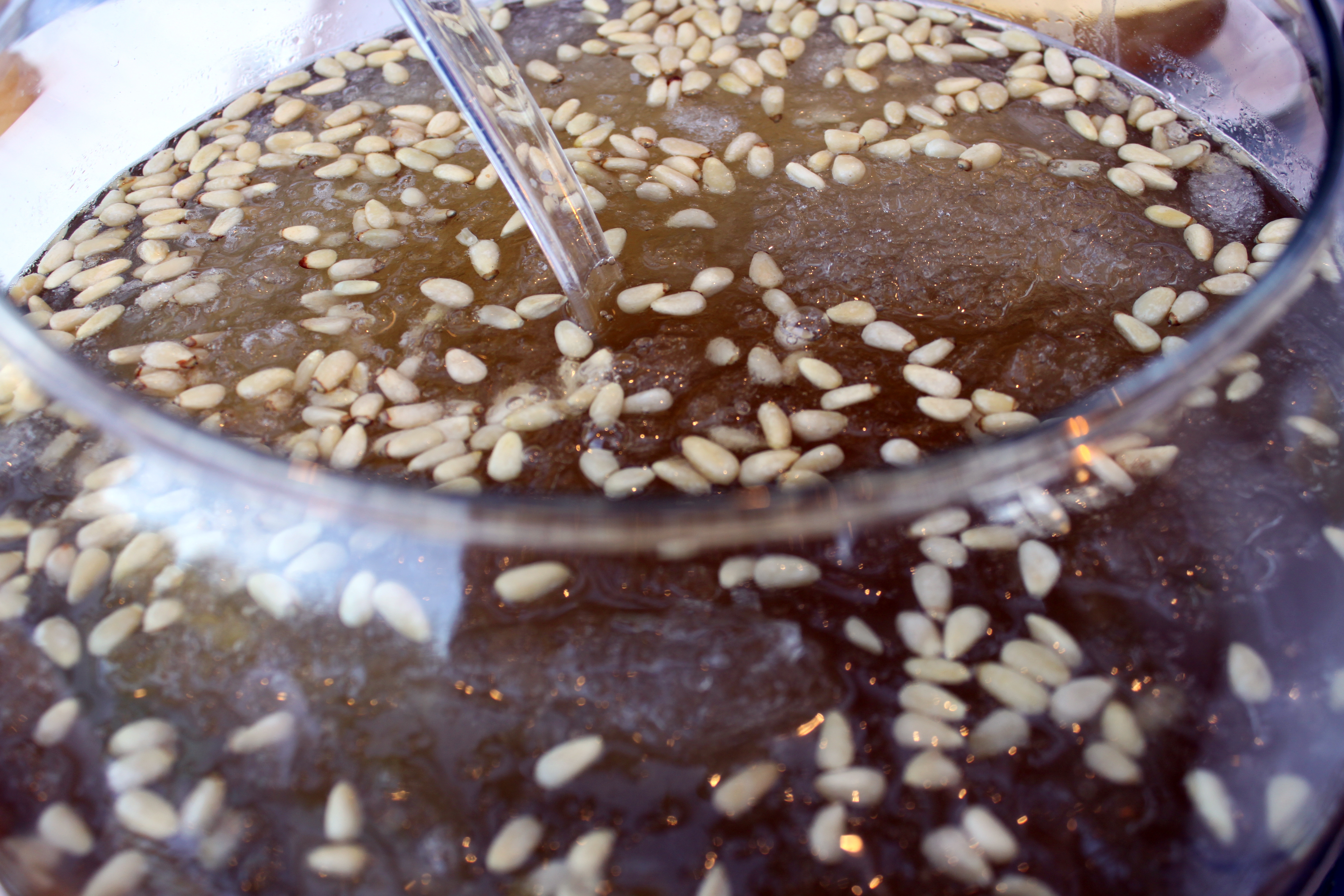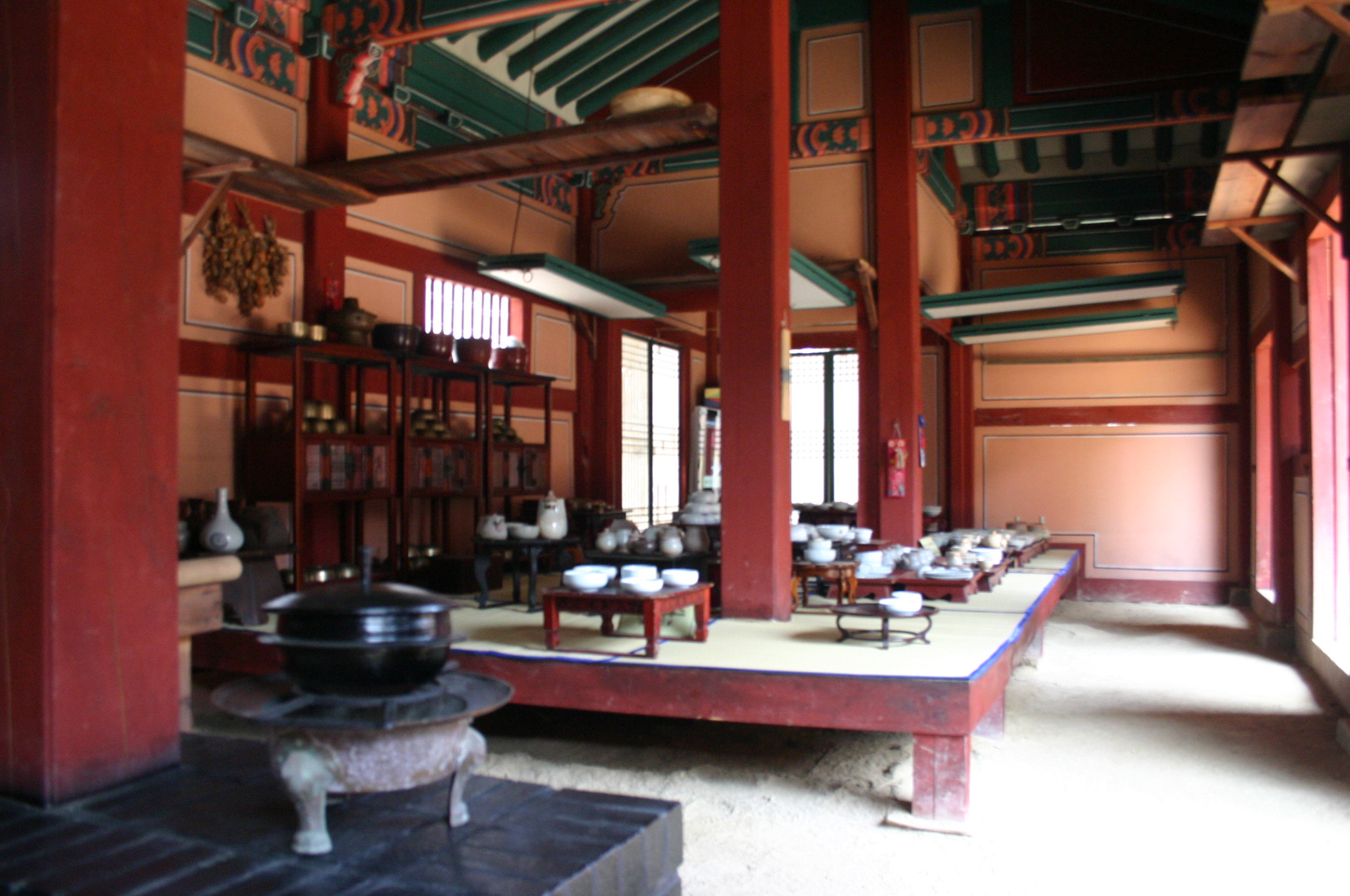|
Jehotang
''Jeho-tang'' () is a traditional Korean cold drink made with honey and several ingredients used in traditional Korean medicine. The ingredients include ''omae'' (, "smoked unripe plums"), ''sain'' (, " medicinal cardamom"), ''baekdanhyang'' (, "white sandalwood"), and ''chogwa'' (, "black cardamom"). The powdered ingredients are mixed together with honey and water and then boiled. After the liquid is chilled, it is diluted in cold water. It was considered the best summer drink in Korean royal court cuisine. See also * ''Hwachae'' (punch) * ''Sikhye'' (rice punch) * '' Ssanghwa-tang'' (medical tea) * ''Sujeonggwa Sujeonggwa is a Korean traditional cinnamon punch. Dark reddish brown in color, it is made from mainly cinnamon, sugar, water and ginger. It's often served with ''gotgam'' (dried persimmon) and garnished with pine nuts. The punch is made by brew ...'' (cinnamon punch) References Herbal tea Korean tea Traditional Korean medicine Korean royal court cuisine ... [...More Info...] [...Related Items...] OR: [Wikipedia] [Google] [Baidu] |
Doopedia
''Doosan Encyclopedia'' is a Korean language encyclopedia published by Doosan Donga (두산동아). The encyclopedia is based on the ''Dong-A Color Encyclopedia'' (동아원색세계대백과사전), which comprises 30 volumes and began to be published in 1982 by Dong-A Publishing (동아출판사). Dong-A Publishing was merged into Doosan Donga, a subsidiary of Doosan Group, in February 1985. The ''Doosan Encyclopedia'' is a major encyclopedia in South Korea. Digital edition EnCyber The online version of the ''Doosan Encyclopedia'' was named EnCyber, which is a blend of two English words: ''Encyclopedia'' and ''Cyber''. The company has stated that, with the trademark, it aims to become a center of living knowledge. EnCyber provides free content to readers via South Korean portals such as Naver. Naver has risen to the top position in the search engine market of South Korea partially because of the popularity of EnCyber encyclopedia. When Naver exclusively contracted Doosan Doo ... [...More Info...] [...Related Items...] OR: [Wikipedia] [Google] [Baidu] |
Herbal Tea
Herbal teas, also known as herbal infusions and less commonly called tisanes (UK and US , US also ), are beverages made from the infusion or decoction of herbs, spices, or other plant material in hot water. Oftentimes herb tea, or the plain term ''tea'', is used as a reference to all sorts of herbal teas. Many herbs are used in herbal medicine. Some herbal blends contain actual tea (e.g., the Indian classic masala chai). The term "herbal" tea is often used in contrast to the so-called ''true'' teas (e.g., black, green, white, yellow, oolong), which are prepared from the cured leaves of the tea plant, '' Camellia sinensis''. Unlike true teas (which are also available decaffeinated), most tisanes do not naturally contain caffeine. There are a number of plants, however, that ''do'' contain caffeine or another stimulant, like theobromine, cocaine or ephedrine. Some have the opposite effect, acting as a sedative. Some common infusions have specific names such as , ''mate'' (ye ... [...More Info...] [...Related Items...] OR: [Wikipedia] [Google] [Baidu] |
Sujeonggwa
Sujeonggwa is a Korean traditional cinnamon punch. Dark reddish brown in color, it is made from mainly cinnamon, sugar, water and ginger. It's often served with ''gotgam'' (dried persimmon) and garnished with pine nuts. The punch is made by brewing first the cinnamon sticks and ginger at a slow boil. The solids are then removed for clarification and the remaining liquid is boiled again after adding either honey or brown sugar. The dried persimmons are cut into portions and are added to soak and soften after the brew has completely cooled. This is usually done several hours before serving, as extensive soaking of the fruit may thicken the clear liquid to a murky appearance. Sujeonggwa is served cold and commonly as a dessert, much like ''sikhye'', due to its sweet taste. It is also widely available in canned form. History The earliest mention of sujeonggwa dates back to 1849 in the book ''Dongguksesigi'' (동국세시기, 東國歲時記), a book of seasonal customs written b ... [...More Info...] [...Related Items...] OR: [Wikipedia] [Google] [Baidu] |
Ssanghwa-tang
''Ssanghwa-tang'' () or ''ssanghwa-cha'' () is a traditional Korean tea with deep brown colour and a slightly bitter taste. Along with sipjeondaebotang, it is one of the most popular types of medical tea in Korea. It is made by boiling down a number of medical herbs such as dried roots of white woodland peony (), steamed and dried roots of rehmannia (), dried roots of Mongolian milkvetch (), dried roots of Korean angelica (), dried roots of lovage (), Chinese cinnamon barks (), and Chinese liquorice (). However, many people today buy the tea pre-made. Efficacy and administration methods Ssanghwangtang is a herbal bath which was enjoyed in the morning and evening during the Joseon Dynasty. Precautions for use should be consulted with a doctor, pharmacist, etc. before taking it, such as patients with hypertension, heart failure or kidney disorder, edema patients, and patients receiving medical treatment. See also * Traditional Korean tea *Traditional Korean medicine ... [...More Info...] [...Related Items...] OR: [Wikipedia] [Google] [Baidu] |
Sikhye
''Sikhye'' (식혜, also spelled ''shikhye'' or ''shikeh''; also occasionally termed ''dansul'' or ''gamju'') is a traditional sweet Korean rice beverage, usually served as a dessert. In addition to its liquid ingredients, S''ikhye'' contains grains of cooked rice and in some cases pine nuts. It is similar to the Chinese ''jiuniang'' and Japanese ''amazake''. It is also a popular beverage in South Korea, often found in the beverage sections of convenience stores. Preparations ''Sikhye'' is made by pouring malt water onto cooked rice. The malt water steeps in the rice at typically 62 degrees Celsius until grains of rice appear on the surface. The liquid is then carefully poured out, leaving the rougher parts, and boiled until it gets sweet enough (no sugar is added to this drink). In South Korea and in overseas Korean grocery stores, ''sikhye'' is readily available in cans or plastic bottles. One of the largest South Korean producers of ''sikhye'' is the Vilac company of Busan ... [...More Info...] [...Related Items...] OR: [Wikipedia] [Google] [Baidu] |
Hwachae
''Hwachae'' () is a general term for traditional Korean punches, made with various fruits or edible flower petals. The fruits and flowers are soaked in honeyed water or honeyed magnolia berry juice. In modern South Korea, carbonated drinks and/or fruit juices are also commonly added to ''hwachae''. Hwachae is often garnished with pine nuts before it is served. Types It is said that there are around thirty types of traditional ''hwachae''. Fruit * ''Aengdu-hwachae'' (; "cherry punch") – made with Korean cherries and honeyed water. It is associated with Dano, the fifth day of the fifth lunar month. * ''Bae-hwachae'' (; "pear punch") – made with flower-shaped pieces of Korean pear and honeyed magnolia berry juice. * ''Boksunga-hwachae'' (; "peach punch") – made with peach preserved in honey and sugared water. * ''Chamoe-hwachae'' (; "melon punch") – made with Korean melon slices, cherries, celery slices, and honeyed magnolia berry juice. * ''Cheondoboksunga-hwa ... [...More Info...] [...Related Items...] OR: [Wikipedia] [Google] [Baidu] |
Academy Of Korean Studies
Academy of Korean Studies (한국학중앙연구원, AKS) is a South Korean research and educational institute with the purpose of establishing profound research on Korean culture. It was established on June 22, 1978, by Ministry of Education & Science Technology of South Korea (교육과학기술부). The Academy has dedicated to interpreting and analyzing Korean culture in general, defining the academic identity of Korean studies, and educating scholars. Korean Studies Journal published by the Academy of Korean Studies *'' Korea Journal'' *''Review of Korean Studies'' *''Korean Studies Quarterly'' Journals not published by the Academy of Korean Studies *''Korean Studies'', Hawaii *''The Journal of Korean Studies'', Seattle *''Encyclopedia of Korean Culture'' *''Acta Koreana'' See also *List of national universities in South Korea *List of universities and colleges in South Korea *Education in Korea Historically, Korea was differently ruled and named. The official records o ... [...More Info...] [...Related Items...] OR: [Wikipedia] [Google] [Baidu] |
Encyclopedia Of Korean Culture
The ''Encyclopedia of Korean Culture'' is a Korean language encyclopedia published by the Academy of Korean Studies and DongBang Media Co. The articles in the encyclopedia are aimed at readers who want to learn about Korean culture and history, and were written by over 3,800 scholars and expert contributors — mainly associated with the Academy of Korean Studies. ''Munhwa Ilbo'' called it the most extensive encyclopedia of Korean studies. In 2001, the digital edition EncyKorea was published on CD-ROM and DVD. See also *'' Doosan Encyclopedia'' * List of digital library projects *Lists of encyclopedias *List of encyclopedias by branch of knowledge *List of encyclopedias by language *List of historical encyclopedias This is a list of encyclopedias, arranged by time period. For other arrangements, see Lists of encyclopedias. Encyclopedias before 1700 * ''Nine Books of Disciplines'' by Marcus Terentius Varro (116 BC-27 BC) * ''Naturalis Historia'' by Pliny the ... * List of ... [...More Info...] [...Related Items...] OR: [Wikipedia] [Google] [Baidu] |
Korean Royal Court Cuisine
Korean royal court cuisine (''Joseon Wangjo Gungjung yori'') was the style of cookery within Korean cuisine traditionally consumed at the court of the Joseon Dynasty, which ruled Korea from 1392 to 1910. There has been a revival of this cookery style in the 21st century. It is said that twelve dishes should be served along with rice and soup, with most dishes served in ''bangjja'' ( bronzeware). History Collectively known as ''gungjung eumsik'' during the pre-modern era, the foods of the royal palace reflected the opulent nature of the past rulers of the Korean peninsula. The opulent nature of the royalty is evidenced in examples as far back as the Silla kingdom, where a man-made lake (Anapji Lake, located in Gyeongju), was created with multiple pavilions and halls for the sole purpose of opulent banquets and a spring fed channel, Poseokjeong, was created for the singular purpose of setting wine cups afloat during the writing of poems. Reflecting the regionalism of the kingdoms ... [...More Info...] [...Related Items...] OR: [Wikipedia] [Google] [Baidu] |
Doosan Corporation
Doosan Corporation is a corporate holding company headquartered in Euljiro 6-ga, Jung-gu, Seoul, South Korea. History * 1896 Park Seung-jik opened Korea's first modern dry goods store, selling cloth. * 1925 Changed the name of Park Seung-Jik Store Limited to Doosan Store * 1953 Established the Oriental Brewery and began producing OB beer. * 1960 Established Dongsan Construction and Engineering (currently Doosan Engineering & Construction)/Acquired Hapdong News Agency (currently Yonhap News) * 1966 Founded Hanyang Food * 1967 Founded Yoonhan Machinery (currently Doosan Mecatec) * 1969 Founded Hankook Bottle and Glass * 1979 Established Doosan CCK Can Manufacturing * 1980 Founded OB Seagram * 1982 Formed OB Bears (currently Doosan Bears) * 1996 Celebrated 100th anniversary. Announced Doosan Group's new Certificate of Incorporation. * 1998 Incorporated nine affiliates and re-launched the company as Doosan Corporation in September. * 2008 Acquired the Chung-Ang University Foundation ... [...More Info...] [...Related Items...] OR: [Wikipedia] [Google] [Baidu] |


